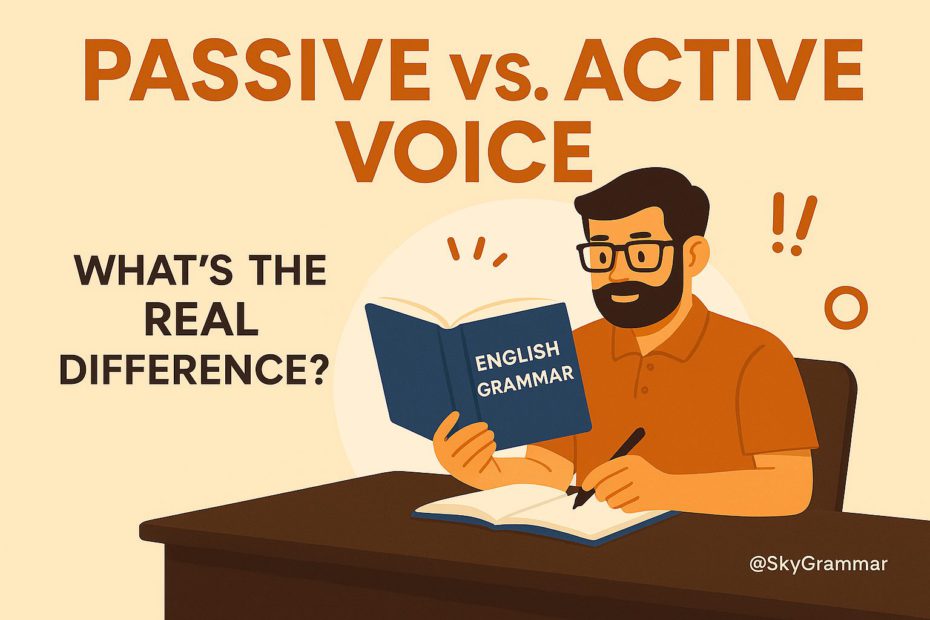In English grammar, “voice” describes how the subject of a sentence relates to the action of the verb. There are two primary forms: active and passive. While both are grammatically correct and widely used, they serve different purposes and affect the tone, clarity, and focus of a sentence.
This guide will help you understand the distinction between active and passive voice, when to use each, and how to recognize them in your writing.
What Is Active Voice?
In an active voice construction, the subject is the one carrying out the action in the sentence.
Structure:
Subject + Verb + Object
Example:
- The chef prepared the meal.
In this example, the chef is the subject, prepared is the verb, and the meal is the object. The focus is on who is doing the action.
Why Use Active Voice?
- It is clear, concise, and direct.
- It strengthens your writing by emphasizing the subject.
- It’s preferred in most forms of writing, including essays, business communication, and journalism.
What Is Passive Voice?
In passive voice, the subject of the sentence receives the action rather than doing it.
Structure:
Object + Form of “to be” + Past Participle (+ by Subject)
Example:
- The meal was prepared by the chef.
Here, the meal (object) becomes the subject of the sentence. The person performing the action—such as the chef—may be mentioned later in the sentence or left out altogether.
Why Use Passive Voice?
- To emphasize the action or the recipient of the action rather than the doer.
- When the doer is unknown, irrelevant, or obvious.
- Common in scientific, academic, or formal writing.
Comparing the Two: Examples
Let’s look at several examples to see the difference more clearly:
| Active Voice | Passive Voice |
|---|---|
| The manager approved the request. | The request was approved by the manager. |
| The dog chased the ball. | The ball was chased by the dog. |
| Researchers conducted the experiment. | The experiment was conducted by researchers. |
Notice how the passive voice places the focus on the object rather than the subject.
When Should You Use Active Voice?
Here are some situations where active voice is generally better:
1. To make writing more engaging
- A sentence like “She solved the puzzle” is much more direct and engaging than “The puzzle was solved by her.”
2. To clarify who is doing what
- The teacher explained the topic clearly.
- They launched the new product in May.
3. To meet expectations in most types of writing
Active voice is expected in most school essays, blog posts, resumes, and workplace reports. It keeps your sentences sharp and avoids unnecessary complexity.
When Is Passive Voice More Appropriate?
While active voice is usually preferred, passive voice has valid uses:
1. When the actor is unknown
- The window was broken during the night.
2. When the focus should be on the action or object
- The vaccine was developed in record time.
- The monument was built in 1920.
3. To sound formal or objective
- The results were analyzed and recorded. (common in scientific writing)
Recognizing Passive Voice
A good way to identify passive voice is to look for a form of “to be” (e.g., is, are, was, were, has been) followed by a past participle (e.g., eaten, written, built).
Test it:
Try adding “by zombies” after the verb. If it makes sense, it’s probably passive voice.
Example:
- The cake was eaten (by zombies). ✅ Passive
- She eats cake (by zombies). ❌ Not passive
How to Convert Passive to Active Voice
If you find yourself using too much passive voice, here’s how to revise it:
Step 1: Identify the object and agent
Passive: The letter was written by Maria.
Step 2: Make the agent the subject
Active: Maria wrote the letter.
Step 3: Remove unnecessary words and clarify the action
- Passive: The meeting was attended by all staff members.
- Active: All staff members attended the meeting.
Benefits of Active Voice in Writing
✅ Improves clarity – Readers can quickly identify the subject and action.
✅ Reduces wordiness – Active voice uses fewer words.
✅ Strengthens tone – Great for persuasive and authoritative writing.
✅ Enhances engagement – Keeps readers interested and focused.
Common Mistakes to Avoid
❌ Overusing passive voice unintentionally
- Especially in emails or essays, overuse makes writing vague or dull.
❌ Misidentifying the subject
- Writers often confuse the object for the subject when using passive constructions.
❌ Leaving out the doer in critical situations
- Mistakes were made. (But who made them?)
Passive Voice Isn’t “Wrong”
There’s a common myth that passive voice is grammatically incorrect. That’s not true—it’s just more formal and less direct. The key is knowing when it’s effective and when it weakens your writing.
Acceptable uses:
- Your application has been received.
- Rules were established to ensure fairness.
Final Thoughts
Understanding the difference between passive and active voice is essential for anyone looking to write clearly and effectively. Use active voice when you want to be direct and confident. The passive voice is useful when the action itself is more significant than the person performing it, or when the doer is unknown or irrelevant.
The goal isn’t to eliminate passive voice entirely—but to use both intentionally.

